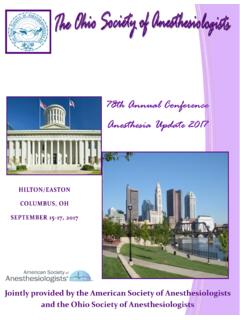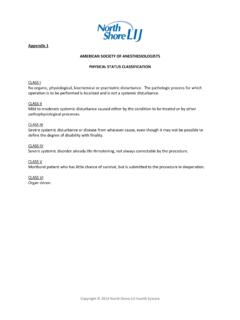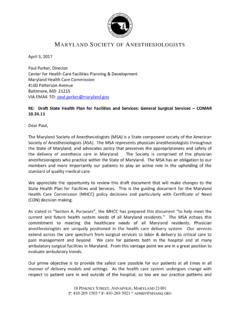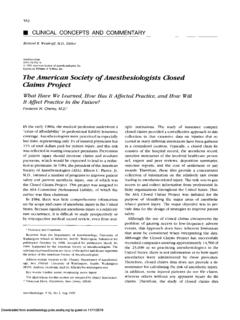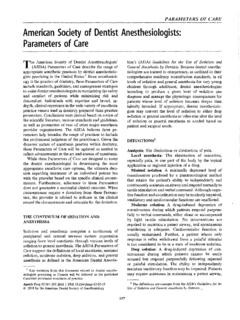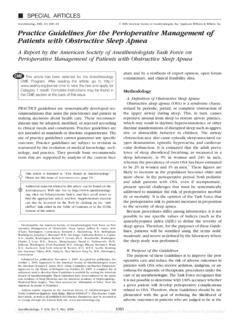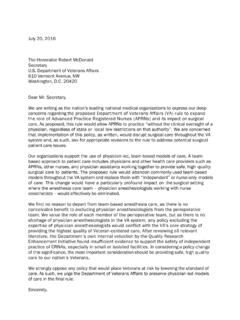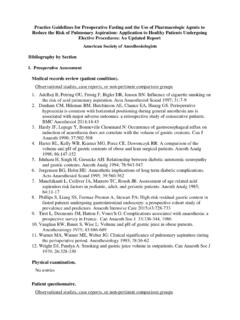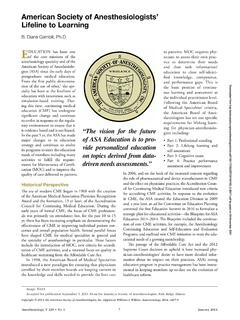Transcription of About Anesthetic Considerations for Elderly Patients
1 Physician Series FREQUENTLY ASKED. QUESTIONS. About Anesthetic Considerations for Elderly Patients Frequently Asked Questions About Anesthetic Considerations for Elderly Patients american society of Anesthesiologists Committee on Geriatric Anesthesia Sheila Ryan Barnett, , Chair Shamsuddin Akhtar, Steven J. Barker, , Ruma Bose, Angela Botts, Ruth E. Burstrom, Deborah J. Culley, Christopher Jankowski, Jacqueline Leung, Michael C. Lewis, Alec Rooke, Raymond C. Roy, , Frederick E. Sieber, Jeffrey H. Silverstein, Zhongcong Xie, , Khwaja Zakriya, Copyright 2009 by the american society of Anesthesiologists. All rights reserved. 2 american society of Anesthesiologists Table of contents Introduction_____ 4. Demographics_ _____ 4. Preoperative Assessment_____ 6. Cardiovascular Issues_____ 9. Pharmacology_ _____11. Postoperative Cognitive Changes_____13. Fluid Management and Trauma_____ 14. Regional and General Anesthetics_____ 16. Sedation_____17. Acute Postoperative Pain_ _____ 18.
2 Tables 1-5. Table 1 - Guidelines for Treating Geriatric Patients_____ 21. Table 2 - The Airway_____ 21. Table 3 - Neuraxial Blocks_ _____ 22. Table 4 - Pharmacotherapy_____ 22. Table - 5 Drug Dosing for the Elderly_____ 23. Recommended reading See ASA curriculum (Please Click Here). This document has been developed by the ASA Committee on Geriatric Anesthesia but has not been reviewed or approved as a practice parameter or policy statement by the ASA. House of Delegates. Variances from recommendations contained in this document may be acceptable based on the judgment of the responsible anesthesiologist . The recommendations are designed to encourage quality patient care and safety in the workplace, but cannot guarantee a specific outcome. They are subject to revision from time to time as warranted by the evolution of technology and practice. FAQ's About Anesthetic Considerations for Elderly Patients 3. Introduction The oldest segment of our population is rapidly expanding.
3 This will lead to an inevitable shift in the mean age of Patients cared for by most practicing anesthesiologists. The following booklet has been composed by the ASA Geriatric Committee to address some of the common geriatric questions facing the anesthesiologist on a daily basis. The booklet has been organized into sections, each one includes a few questions About the topics. This is not meant to replace any of the excellent texts or reviews available but instead to supplement the reading for ASA members. Demographics How have the demographics in the US of the Elderly population changed over the last 100 years? The entire US population almost tripled during the 20th century and the geriatric segment of the population alone grew tenfold. Whereas only 4% of the population;. less than 5 million individuals, was over 65 years old at the turn of the century, the number of people age 65 and older now constitutes 12% of the population. It is estimated that the number of Elderly will double again by 2040.
4 The oldest old, those greater than 85 years of age, represent the fastest growing segment of the population. Although octogenarians account for only 12% of all Elderly now; they are predicted to constitute almost 20% of the Elderly population by 2040. The number of centenarians is increasing even faster - from only 57,000 in 1996 to a predicted 447,000 persons by 2040. Thus, not only is the absolute number of older Americans increasing but the overall US population is also becoming older with proportionally fewer individuals under 65 years of age. What impact has the change in Elderly demographics had on perioperative services? The growth in the geriatric population impacts perioperative services through an increase in the number of surgical procedures and utilization of perioperative services. Patients over age 65 years represent approximately 12% of the population but account for 33% of heath care costs, 38% of hospital bed stays, and 21% of inpatient surgical procedures.
5 Forty percent of Medicare inpatients suffer a minor or major medical, surgical, or anesthesia-related complications during hospitalization for non-cardiac surgery; 8% experience a failure to rescue event; and 4% die in the perioperative period. 4 american society of Anesthesiologists What percentage of the surgical patient base will be made up of Elderly Patients over the next 20 years? The expected growth of surgical procedures performed in older Americans in future years will not be uniform across surgical specialties. Those specialties in which Elderly Patients are already well represented are projected to have greater increases in workloads. The estimated surgical work load for the Elderly strongly parallels the number of procedures performed by each specialty currently. Ophthalmology has the largest forecasted increase - 15% by 2010, and 47% by 2020. These projections reflect that older Patients are the predominant consumers of cataract surgery which make up 55% of the overall procedure-based workload of ophthalmologists.
6 The incidence of cataracts in individuals 65 years or older is over 8 times the incidence in Patients 45. to 64 years of age, thus the projected increase in numbers are not surprising. Currently 70% of cardiothoracic surgery procedure-based work is derived from Patients 65 years old or older. In the absence of a paradigm shift in indications, funding mechanisms for heart surgery and no change in what can be accomplished by interventional cardiologists, the growth in surgical work over the next 20. years for cardiothoracic surgeons could be as high as 42%. Similarly, the profile of age-specific use of neurosurgical procedures is estimated to grow by 15% by 2010 and 28% by 2020. How do demographic changes in the Elderly population affect the health care budgets? As the number of geriatric Americans increase and the US population becomes older, there will be proportionally fewer individuals under 65 years to fund the retirement and health care of those older than 65 years.
7 At the same time the aging of the baby boomers is increasing the cost of health care dramatically. This perfect storm is likely to force a revamping of how health care is funded in the United States in the very near future. Table 1. Early 1980's 2005. Population million million Americans over 65 million million Life Expectancy of Americans years * (*2002). Americans 85 or Older million million National Health Expenditures 247 billion $1,542 billion FAQ's About Anesthetic Considerations for Elderly Patients 5. Preoperative Assessment Does age in itself increase the risk of anesthesia? Advanced age is a consistent risk factor for increased morbidity and mortality after anesthesia, however this is most likely due to coexisting diseases. There is no evidence that age by itself increases perioperative risk in the absence of co-morbid conditions. The incidence of chronic disease increases steadily with advancing age and it is the severity of acquired chronic disease that is the primary contributor to the risk of anesthesia and elective surgery in the older surgical patient.
8 Technically the ASA status, an assessment of the severity of preoperative co- morbid illnesses, does not include age as a criterion. However some anesthesiologists routinely assign an ASA II classification to otherwise healthy Patients over 65 years old. This practice should probably be re-examined, since as stated, age by itself does not necessarily increase perioperative risk. What are some of the common complications which should be discussed with older Patients ? Postoperative complications depend on the type of surgery and the preoperative co-morbidities. Overall complications occur more frequently in the Elderly because older Patients are more likely to have co-morbid conditions than their younger counterparts. The most frequently occurring postoperative complications in older Patients involve the heart, brain, lungs and the kidneys. Avoiding complications is important, as the occurrence of a complication postoperatively, has been shown to be associated with increased morbidity and mortality.
9 The likelihood of a complication will depend most on the patient's underlying functional reserve and co-morbidities. Both age and co-morbid disease contribute to the loss of functional reserve of all organs and most importantly, the heart, lungs, brain, and kidneys. Decreased functional organ reserve diminishes the ability of older Patients to restore homeostasis that is distorted by the physiologic changes caused by disease, surgery, and anesthesia and increases perioperative risk. For the older patient a discussion regarding potential complications should include what might be expected for any adult for example in the patient with underlying cardiac or pulmonary disease and so on. In the older patient however, the risk of cognitive issues post surgery are more significant. These may manifest as delirium or the more subtle changes of post operative cognitive dysfunction, both discussed in greater detail below. What questions pertinent to the Elderly should be asked during a preoperative interview?
10 The preoperative interview provides the opportunity to assess organ reserve capacity by evaluating the mental and physical status of the patient. Diseases involving the cardiovascular, pulmonary, renal, and central nervous system occur with increasing frequency in the Elderly and the symptoms may be atypical. 6 american society of Anesthesiologists During the preoperative interview questions should be focused on assessing the functional state of the older patient, this may provide an estimate of the patient's reserve and ability to tolerate a significant surgery. Simple questions About how far the patient can walk, and what are their daily activities may reveal significant limitations that otherwise may not have been apparent. In contrast to most younger Patients , cognitive impairment is more likely to be present in older Patients , reflecting the increasing incidence of dementia and central neurologic disease found in the geriatric age group. Cognitive impairment increases the risk of developing postoperative cognitive dysfunction and delirium following surgery.
